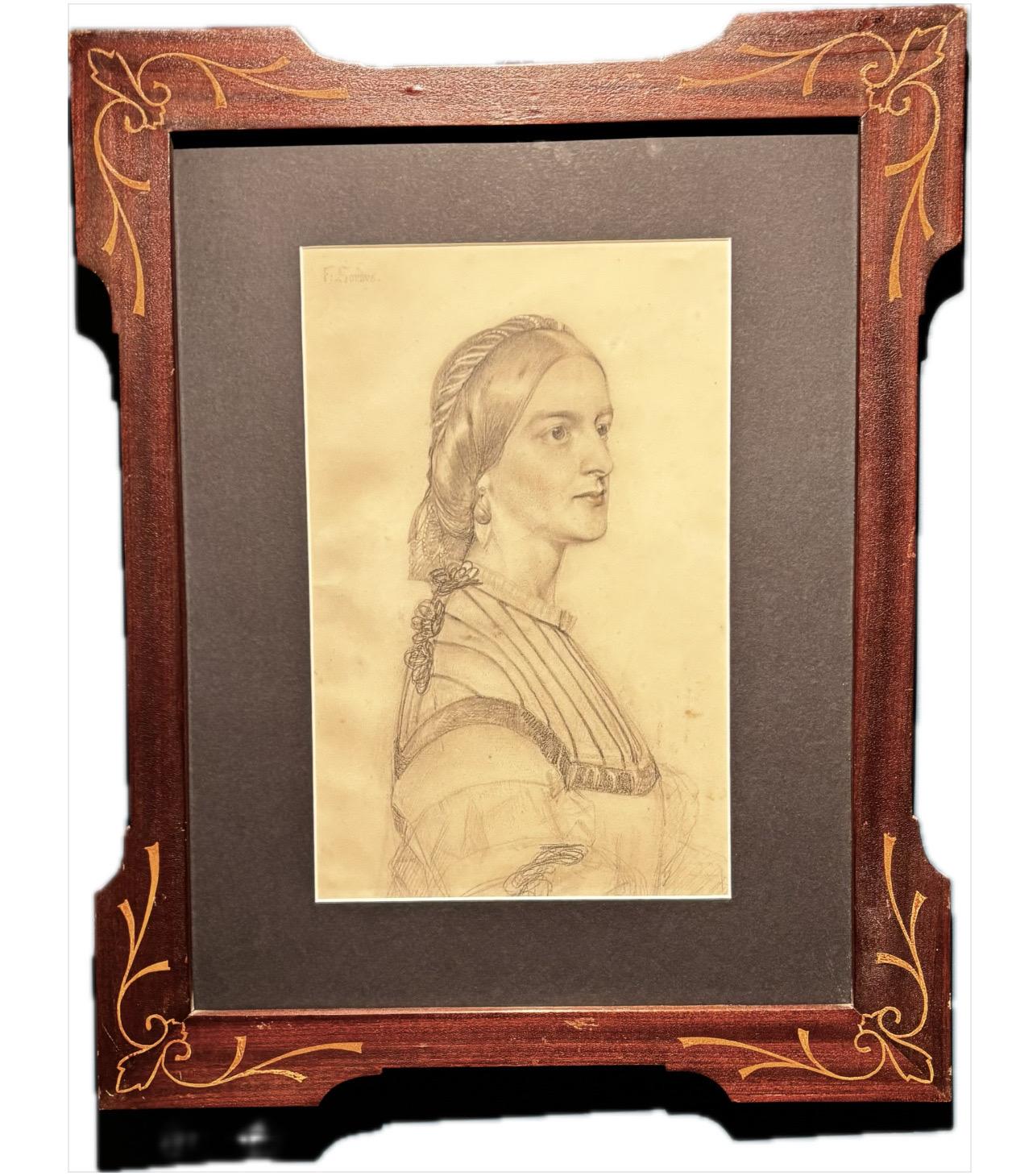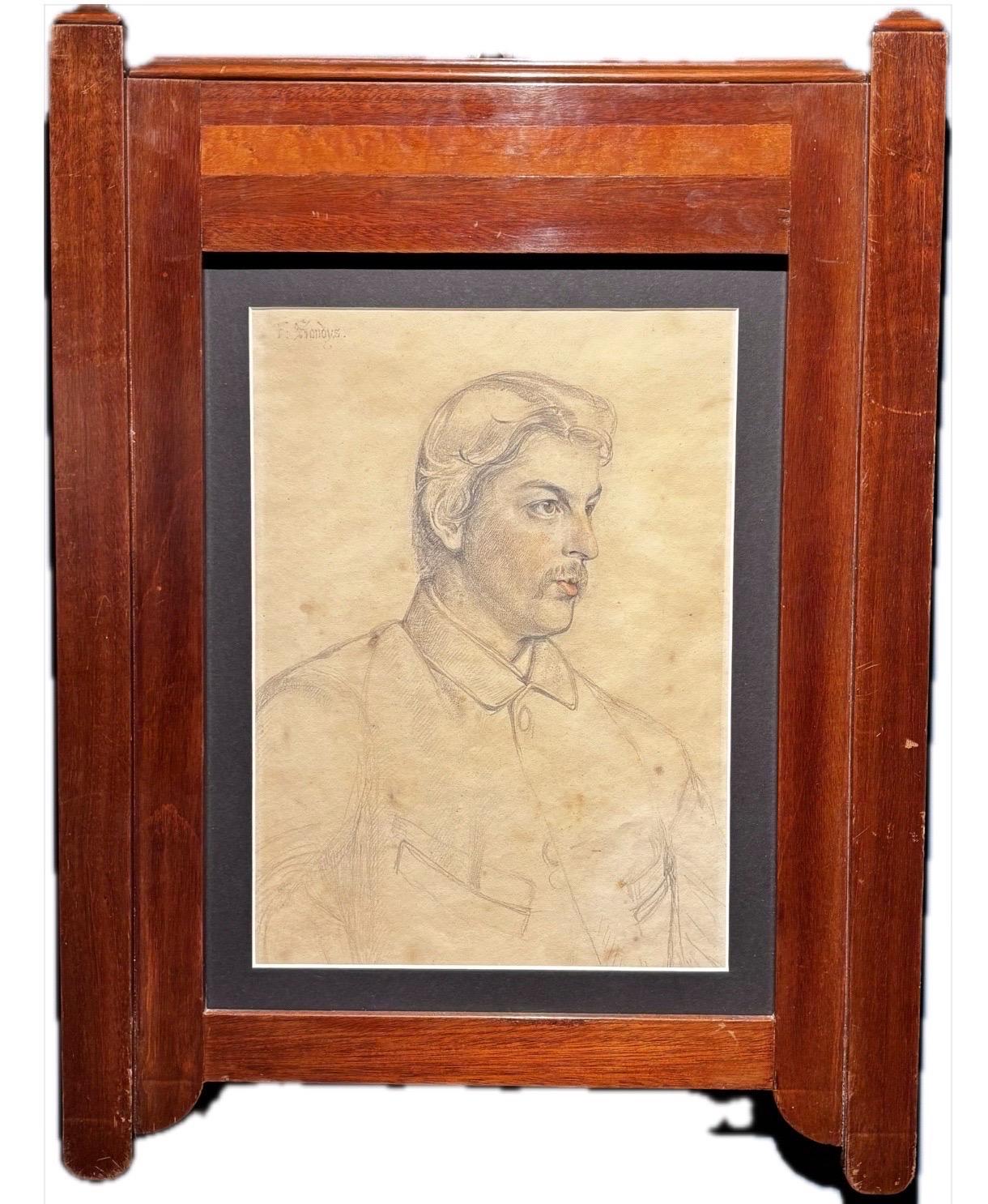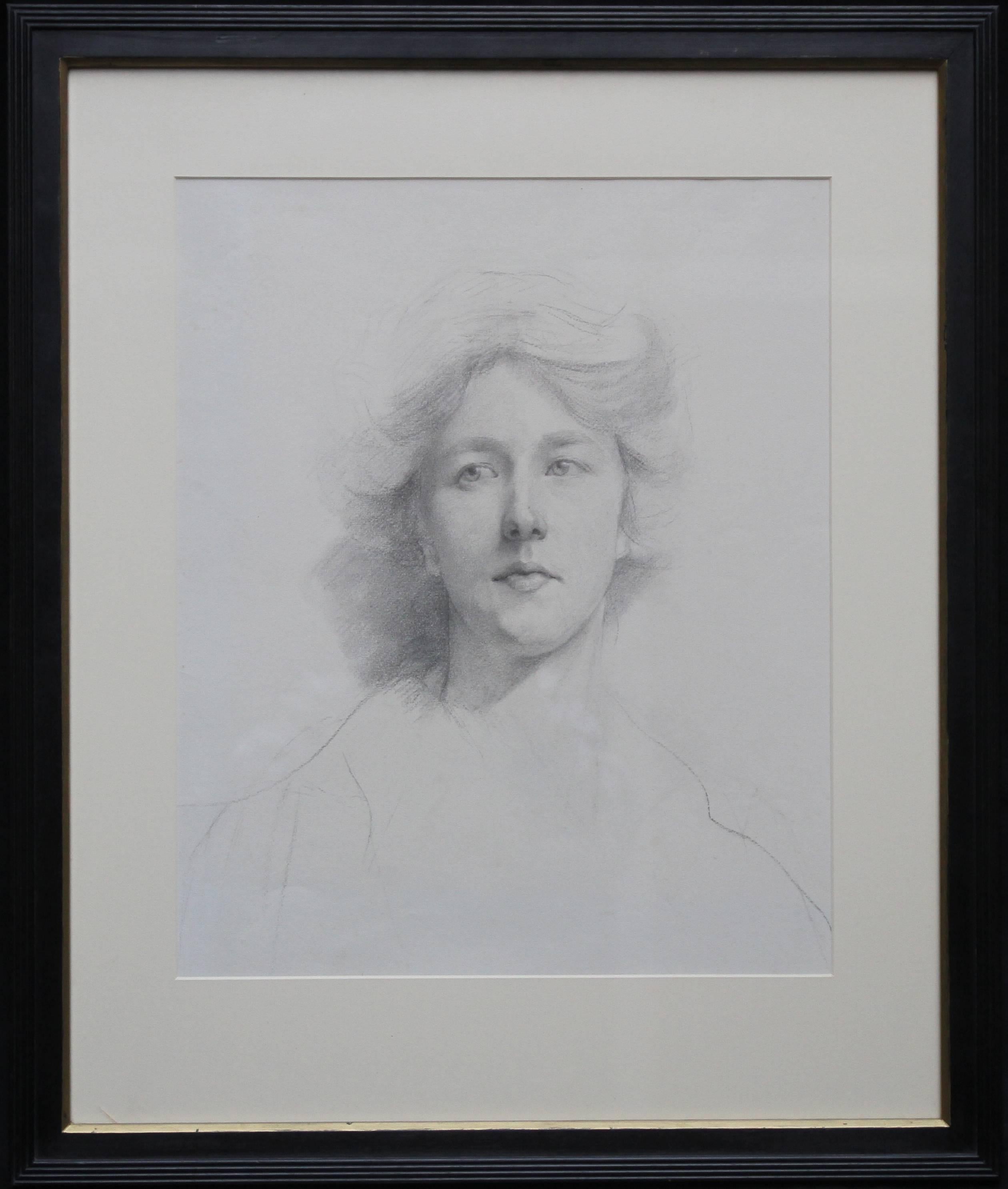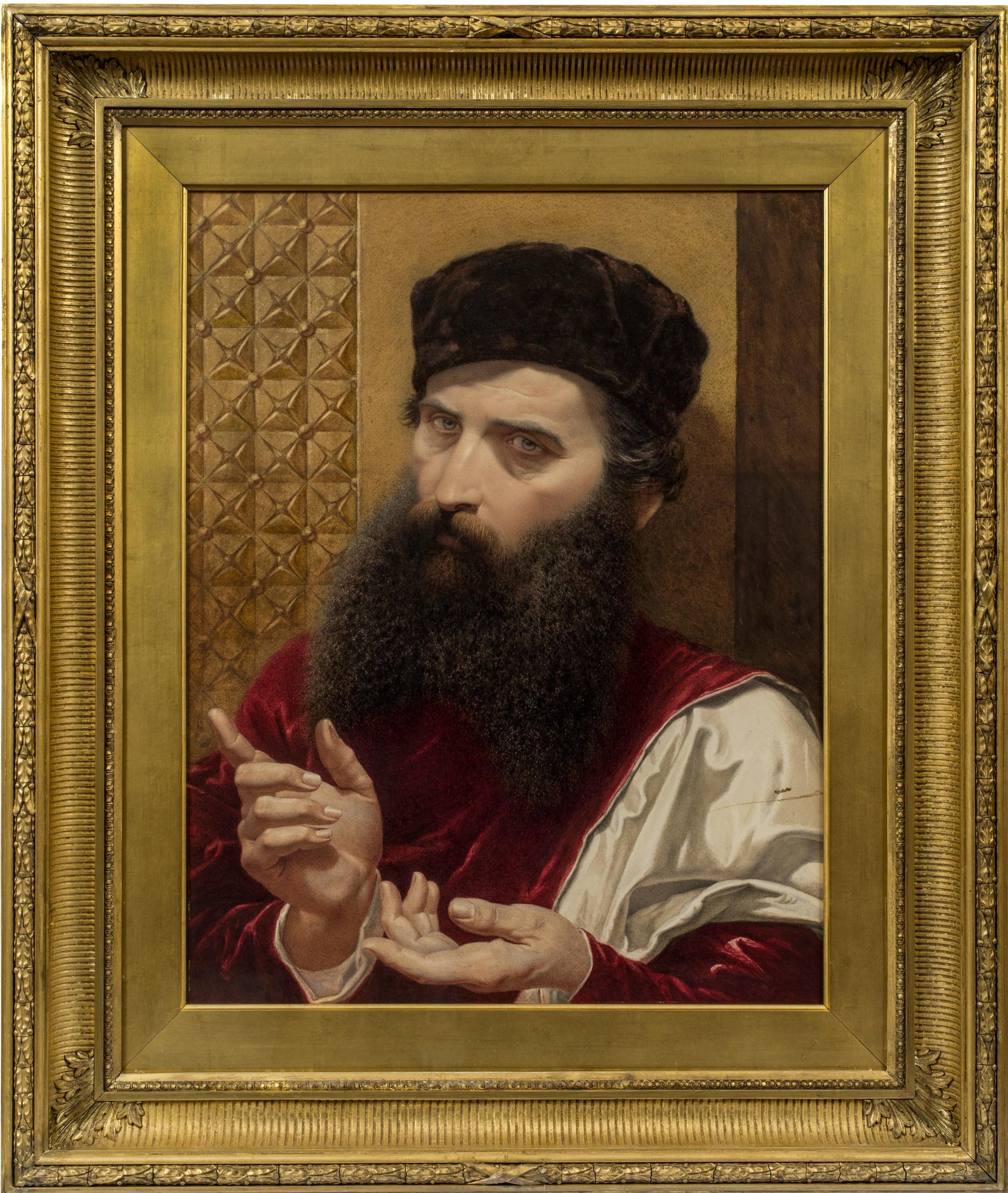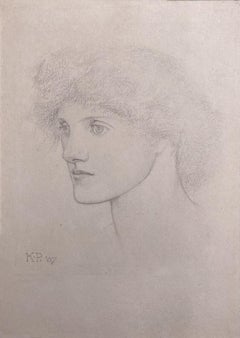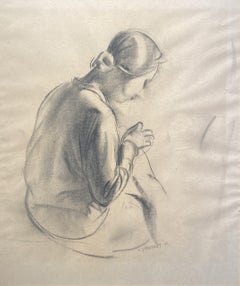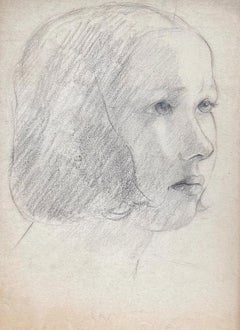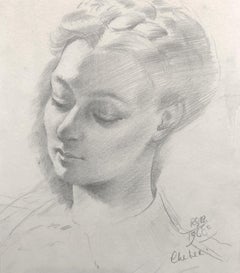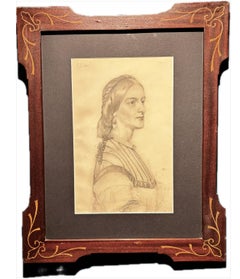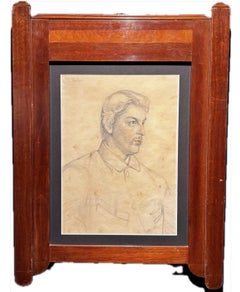Items Similar to Portrait Studies
Want more images or videos?
Request additional images or videos from the seller
1 of 4
Edwin Longsden LongPortrait Studies
About the Item
Edwin Long
1829 - 1891
Portrait Studies
Graphite on paper
Image size: 4 x 8 inches (10 x 20.5 cm)
Framed
Edwin Longsden Long RA (1829-1891, British) was the son of an artist and born in Bath, Somerset, England. Long was a portrait painter also known for his English genre and Orientalist works. Long went to London where he studied art at the British Museum. Afterwards, he travelled to Spain where he became influenced by the paintings of Velasquez. In 1874, he travelled to Syria and Egypt where he became interested in romantic oriental scenes.
- Creator:Edwin Longsden Long (1829 - 1891, British)
- Dimensions:Height: 4 in (10.16 cm)Width: 8 in (20.32 cm)
- More Editions & Sizes:4 x 8 inchesPrice: $1,630
- Medium:
- Movement & Style:
- Period:
- Condition:
- Gallery Location:London, GB
- Reference Number:1stDibs: LU52410997242
About the Seller
5.0
Gold Seller
Premium sellers maintaining a 4.3+ rating and 24-hour response times
Established in 2007
1stDibs seller since 2014
80 sales on 1stDibs
Typical response time: 5 hours
- ShippingRetrieving quote...Shipping from: London, United Kingdom
- Return Policy
Authenticity Guarantee
In the unlikely event there’s an issue with an item’s authenticity, contact us within 1 year for a full refund. DetailsMoney-Back Guarantee
If your item is not as described, is damaged in transit, or does not arrive, contact us within 7 days for a full refund. Details24-Hour Cancellation
You have a 24-hour grace period in which to reconsider your purchase, with no questions asked.Vetted Professional Sellers
Our world-class sellers must adhere to strict standards for service and quality, maintaining the integrity of our listings.Price-Match Guarantee
If you find that a seller listed the same item for a lower price elsewhere, we’ll match it.Trusted Global Delivery
Our best-in-class carrier network provides specialized shipping options worldwide, including custom delivery.More From This Seller
View AllHead of a Young Woman
Located in London, GB
Karl Parsons
English 1884 - 1934
Head of a Young Woman
Graphite on paper
Signed and dated '(19)07' lower left
Image size: 6 1/4 x 8 1/2 inches (16 x 21.5 cm)
Contemporary Pre-Raphaelite style frame
One of Britain's leading stained glass designers during the early decades of the 20th century, Karl Parsons drew portraits invariably for pleasure rather than commissions, throughout his life, and it is in these that one sees most clearly the influence of some of the artists whom he most admired, notably Botticelli, Rossetti and Burne-Jones.
Though harkening back to these illustrious forebears, both technically and compositionally, this portrait also epitomises the type of portraiture that was fashionable in British high society at the start of the 20th century. Karl Parson's technique here, with delicate shading and strong outlines, is certainly comparable to Gerald Leslie Brockhurst's graphic style. It is clear that Parsons took delight in demonstrating his skill at sculpting human forms through gentle shading.
Karl Parsons was an English stained glass artist associated with the arts and craft movement. Parsons was born in Peckham in Surrey in 1884, the 12th child of Arthur William Parsons...
Category
Early 20th Century Pre-Raphaelite Portrait Drawings and Watercolors
Materials
Graphite
Mending, Graphite Portrait, 20th Century Modern British, Signed Artwork
By James Stroudley
Located in London, GB
Graphite on paper, signed lower right
Image size: 17 x 21 inches (43.25 x 53.25 cm)
Contemporary frame
James Stroudley
Stroudley was born in London on 17 June 1906, the son of James Stroudley, showcard and ticket writer. He studied at Clapham School of Art (1923-27) and then at the Royal College of Art (1927-30), where his teachers included Alan Gwynne-Jones and William Rothenstein. As a recipient of the first Abbey Scholarship he was able to spend three years in Italy from 1930, where he absorbed the influences of Giotto and Piero della Francesca, and produced one of the last wholly satisfying decorative cycles by a Rome Scholar of the period. From 1934, he exhibited at the Royal Society of British Artists, and was elected to its membership in the following year.
From the Second World War – in which he worked with the Camouflage Unit – Stroudley taught at St Martin’s School of Art and was a visiting lecturer at the Royal Academy Schools. Though he continued to live in London, his later work, exhibited at the Royal Academy from 1955, indicated regular painting trips to Kent and Sussex coasts. However, much of his later work was abstract. In 1971, his former student, Peter Coker, paid homage to Stroudley by including his work in the exhibition ‘Pupil & Masters’, held at Westgate House, Long Melford, Suffolk.
Stroudley married three times, and his wives included the fashion artist to the Sun newspaper...
Category
20th Century English School Portrait Drawings and Watercolors
Materials
Paper, Graphite
The New Haircut, 20th Century portrait of a Young Girl, drawing
Located in London, GB
Graphite on paper
Image size: 11 ¾ x 8 ½ inches (30 x 21.5 cm)
Original frame
This superbly-drawn portrait highlights the artist’s undeniable skill as a portrait artist, particularl...
Category
20th Century Modern Portrait Drawings and Watercolors
Materials
Paper, Graphite
Chelsea, Graphite Portrait, English School 20th Century
Located in London, GB
Graphite on paper, initialled and dated 1960
Image size: 8 x 6 inches (20 x 15 cm)
Handmade frame
Category
1960s English School Portrait Drawings and Watercolors
Materials
Graphite
The Gaze, Signed Graphite 20th Century Portrait
Located in London, GB
Graphite on paper, signed bottom right
Image size: 13 x 8 3/4 inches (33 x 22.25 cm)
Original frame
Dora Thacher Clarke, later Dora Middleton, (1895–1989) was a British sculptor and wood carver who also wrote about, and promoted African art.
Clarke was born in Harrow in Middlesex. Her father, Joseph Thacher Clarke was an American architect. Clarke won a scholarship that allowed her to attend the Slade School of Fine Art. Aged fifteen, Clarke initially studied at the Slade on a part-time basis for three days each week throughout 1910 and 1911 but during 1915 and 1916 she studied sculpture there as a full-time student. Clarke first exhibited at the Royal Academy in 1923 and continued to do so until 1959. In the early 1930s she was a regular exhibitor in group shows at the Goupil Gallery and in March 1937 had her first solo show at the French Gallery. She also exhibited at the Paris Salon and with the Royal Society of British Artists.
Clarke's works included bronze castings, memorials and wood sculptures, often of African heads. For example she was commissioned to sculpt the posthumous portrait bust of Sir Walter Morley Fletcher. The most notable of her memorials is the panel and medallion tribute to Joseph Conrad at Bishopsbourne in Kent, which was unveiled in 1927. Clarke also wrote about, and promoted African art and spent a year, between 1927 and 1928 in Kenya, where she made many drawings which when she returned to London she used as the basis for wood carvings and bronzes of tribal figures. Wood carving became her technique of choice, often working with hardwoods and, on occasion, sperm whale teeth.
Clarke married Admiral Gervase B Middleton in 1938 but rarely exhibited work under her married name. During World War II, Clarke was commissioned by the War Artists' Advisory Committee to produce a portrait medallion depicting a serviceman who had been awarded the George Cross. This proved to be the only portrait medallion acquired for the WAAC collection.
Sculptures by Clarke are held in various museums, including the Ashmolean Museum which also holds a 1936 portrait of her by Orovida Camille Pissarro.
Category
Mid-20th Century English School Portrait Drawings and Watercolors
Materials
Graphite
A Study of Thomas Cooper Gotch, 19th Century Graphite Sketch
Located in London, GB
Graphite on paper
Image size: 5 1/2 x 20 1/2 inches (14 x 52 cm)
Framed
This sketch is a portrait of Thomas Gotch is by his lifelong friend and confidante, Jane Ross, whom he met at...
Category
Mid-19th Century English School Portrait Drawings and Watercolors
Materials
Graphite
You May Also Like
" Studio per Ritratto di Lady Anne Simms Reeve of Brancaster Hall " 1870 ca
Located in Torino, IT
Raro studio dell'artista Preraffaellita Frederick Sandys,Studio per l’opera
Portrait of a Lady,( Anne Simms Reeve of Brancaster Hall, Norfolk) proprie...
Category
1870s Pre-Raphaelite Portrait Drawings and Watercolors
Materials
Crayon, Graphite
" Studio per ritratto di Philip Bedingfeld" 1870 ca cm. 25 x 36
Located in Torino, IT
Studio a matita e pastelli per lo splendido ritratto di Philip Bedingfeld proprietà del Museo del Norfolk
Frederick Sandys, (Norwich, 1º maggio1829 ...
Category
1870s Pre-Raphaelite Portrait Drawings and Watercolors
Materials
Crayon, Graphite, Paper
Self Portrait - British Italian art Edwardian pencil drawing female artist
By Estella Canziani
Located in London, GB
This is a fine detailed and superbly executed Edwardian drawing by Estella Canziani which dates to circa 1911. Executed by one of the leading artists of the day it is a very strikin...
Category
1910s Pre-Raphaelite Portrait Drawings and Watercolors
Materials
Pencil
Portrait of a Lady - Pre-Raphaelite art Victorian drawing young woman
Located in London, GB
This beautiful Victorian pencil drawing dates to around 1890 and is by an unknown hand. It is a profile head and shoulders portrait of a young lady sat in a chair. Her dark hair is t...
Category
19th Century Pre-Raphaelite Portrait Drawings and Watercolors
Materials
Charcoal, Pencil
$3,910 Sale Price
20% Off
The Argument
Located in New York, NY
Signed and inscribed on a label on the verso:
No. 1/ The Argument/ W. Cave Thomas/ 203 Camden Rd/ NW
Provenance:
Christie’s, London, 6 November 1995, lot 88.
Private Collection, London.
This powerful watercolor is a mature work by the little-known Victorian painter William Cave Thomas...
Category
19th Century Pre-Raphaelite Portrait Drawings and Watercolors
Materials
Paper, Watercolor, Pencil
Portrait of Elaine Blunt - British 19th century art Pre-Raphaelite chalk drawing
By Edward Robert Hughes
Located in London, GB
This captivating Victorian sanguine chalk portrait drawing of a young girl is by Pre-Raphaelite British artist Edward Robert Hughes. Signed and dated 1896, Hughes depicts in great detail her sweet young face and beautiful dress which appears to almost glow with light. A full length portrait and a really lovely drawing epitomising childhood innocence. The portrait depicts Elaine Blunt and has an inscription from Edward Hughes verso.
Signed and dated lower right.
Provenance. Colchester estate.
Sotheby Lot 283 29th June 1976
Chapman Bros
Condition. Sanguine chalk on paper, 28 inches by 20 inches unframed and in good condition.
Housed in a glazed oak frame, 37 inches by 29 inches framed and in good condition.
Edward Robert Hughes - Not to be confused with Edward Hughes (1832 - 1908), who specialised in portrait painting. Edward Robert Hughes RWS (1851 – 1914) was an English painter who worked prominently in watercolours, but also produced a number of significant oil paintings. He was influenced by his uncle and eminent artist, Arthur Hughes who was associated with the Pre-Raphaelite Brotherhood, and worked closely with one of the Brotherhood's founders, William Holman Hunt. Having settled on his career choice, Edward Robert Hughes attended Heatherley's in London to prepare himself for the chance of auditioning for the Royal Academy School. Hughes became a student at the Royal Academy School in 1868. While Pre-Raphaelitism played an influential part in shaping Hughes work, Aestheticism is also seen in his paintings. E.R. Hughes is widely known for his works Midsummer Eve and Night With Her Train of Stars yet he built a career as a portrait painter to the upper classes. In addition to being an accomplished artist himself, E.R. Hughes was also a studio assistant to the elder artist and Pre-Raphaelite Brotherhood founding member William Holman Hunt when Hunt suffered from glaucoma. Two of the paintings that Hughes worked on with Hunt were The Light of the World, which is displayed in St Paul's Cathedral, and The Lady of Shalott, which is exhibited at the Wadsworth Atheneum. On his own he experimented with ambitious techniques and was a perfectionist; he did numerous studies for many of his paintings, some of which turned out to be good enough for exhibition. Hughes held several important offices within the artistic community over his lifetime such as becoming a member of the Art Workers Guild in 1888, and was on their committee from 1895 to 1897. He was elected to Associate Membership of The Royal Water Colour Society (ARWS) on 18 February 1891, and he chose as his diploma work for election to full membership a mystical piece (Oh, What's That in the Hollow?) inspired by a verse by Christina Rossetti entitled Amor Mundi. His painting A Witch was given by the Royal Watercolour Society to King Edward VII and Queen Alexandra to mark the coronation in 1902. In later years Hughes served as the Vice-President of the RWS before leaving in 1903. Throughout his career, E.R. Hughes exhibited his works in several galleries around London: Dudley Gallery, Grosvenor Gallery, New Gallery, The Royal Academy, and toward the end of his career he exhibited with The Royal Society of Painters in Water Colours (RWS). His works can be seen in public collections including Cartwright Hall, Bradford, Cambridge & County Folk Museum, Maidstone Museum & Art Gallery, Bruce Castle...
Category
19th Century Pre-Raphaelite Portrait Drawings and Watercolors
Materials
Chalk

